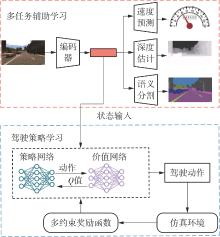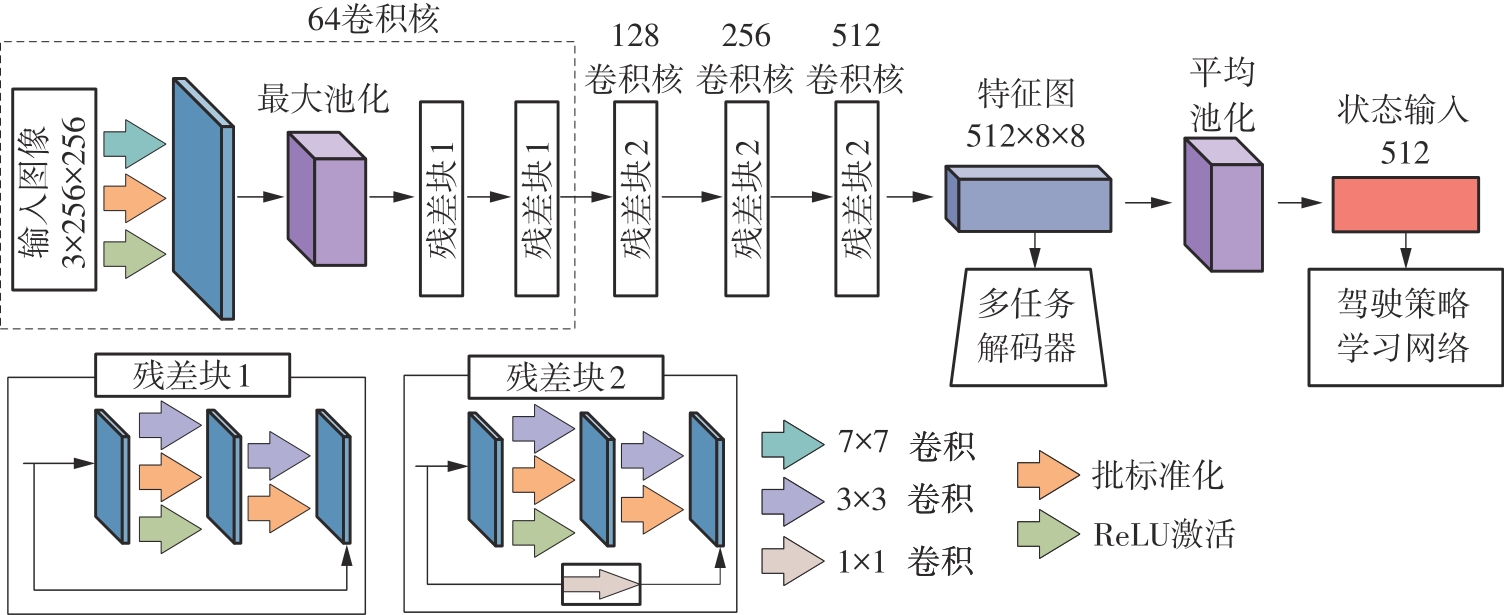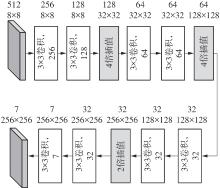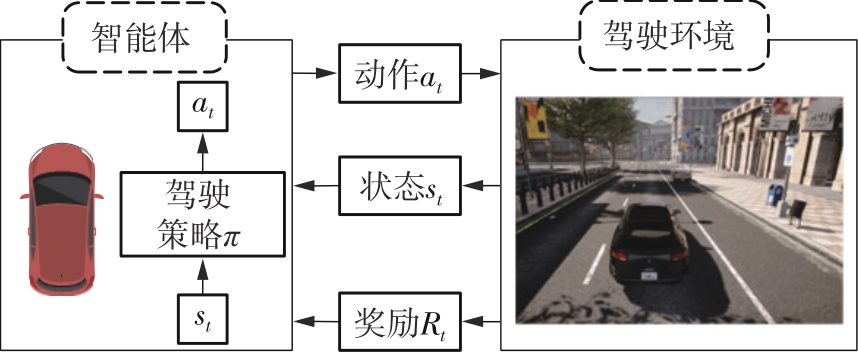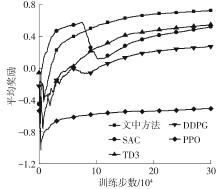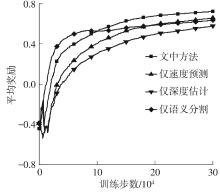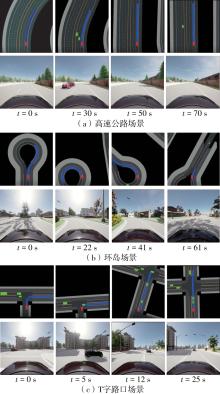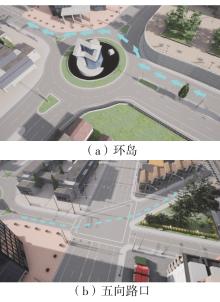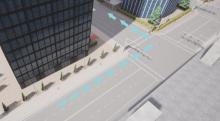Journal of South China University of Technology(Natural Science Edition) ›› 2024, Vol. 52 ›› Issue (10): 31-40.doi: 10.12141/j.issn.1000-565X.230503
Special Issue: 2024年计算机科学与技术
• Computer Science & Technology • Previous Articles Next Articles
Multi-Task Assisted Driving Policy Learning Method for Autonomous Driving
- School of Mechanical and Automotive Engineering/ Guangdong Provincial Key Laboratory of Automotive Engineering,South China University of Technology,Guangzhou 510640,Guangdong,China
-
Received:2023-08-01Online:2024-10-25Published:2024-01-31 -
Supported by:the Special Fund for High-Quality Development of the Manufacturing Industry of the Ministry of Industry and Information Technology(R-ZH-023-QT-001-20221009-001)
CLC Number:
Cite this article
LUO Yutao, XUE Zhicheng. Multi-Task Assisted Driving Policy Learning Method for Autonomous Driving[J]. Journal of South China University of Technology(Natural Science Edition), 2024, 52(10): 31-40.
share this article
Table 2
Quantitative test results under two scenarios"
| 场景 | 模型 | 成功率/% | 驾驶分数 | ||||
|---|---|---|---|---|---|---|---|
| 车流密度 为10辆 | 车流密度 为50辆 | 车流密度 为100辆 | 车流密度 为10辆 | 车流密度 为50辆 | 车流密度 为100辆 | ||
| 环岛场景 | MA-DPL | 100 | 99 | 87 | 100.00 | 99.13 | 88.31 |
| SAC | 93 | 80 | 75 | 93.79 | 81.51 | 77.03 | |
| TD3 | 96 | 89 | 70 | 96.39 | 90.02 | 72.54 | |
| DDPG | 98 | 80 | 73 | 98.11 | 81.97 | 75.18 | |
| 五向路口场景 | MA-DPL | 98 | 96 | 84 | 98.34 | 96.44 | 85.31 |
| SAC | 96 | 69 | 43 | 96.29 | 71.85 | 47.35 | |
| TD3 | 93 | 85 | 41 | 93.71 | 86.26 | 45.21 | |
| DDPG | 98 | 72 | 42 | 98.12 | 74.45 | 46.38 | |
| 1 | ELALLID B B, BENAMAR N, HAFID A S,et al .A comprehensive survey on the application of deep and reinforcement learning approaches in autonomous driving[J].Journal of King Saud University-Computer and Information Sciences,2022,34(9):7366-7390. |
| 2 | 林泓熠,刘洋,李深,等 .车路协同系统关键技术研究进展[J].华南理工大学学报(自然科学版),2023,51(10):46-67. |
| LIN Hongyi, LIU Yang, LI Shen,et al .Research progress on key technologies in the cooperative vehicle infrastructure system[J].Journal of South China University of Technology (Natural Science Edition),2023,51(10):46-67. | |
| 3 | HEJASE B, YURTSEVER E, HAN T,et al .Dynamic and interpretable state representation for deep reinforcement learning in automated driving[J].IFAC-PapersOnLine,2022,55(24):129-134. |
| 4 | HUANG C, ZHANG R, OUYANG M,et al .Deductive reinforcement learning for visual autonomous urban driving navigation[J].IEEE Transactions on Neural Networks and Learning Systems,2021,32(12):5379-5391. |
| 5 | ZHU M, WANG X, WANG Y .Human-like autonomous car-following model with deep reinforcement learning[J].Transportation Research Part C:Emerging Technologies,2018,97:348-368. |
| 6 | KENDALL A, HAWKE J, JANZ D,et al .Learning to drive in a day[C]∥ Proceedings of 2019 International Conference on Robotics and Automation.Montreal:IEEE,2019:8248-8254. |
| 7 | DOSOVITSKIY A,ROS G, CODEVILLA F,et al .CARLA:an open urban driving simulator[C]∥ Proceedings of the 1st Conference on Robot Learning.New York:ML Research Press,2017:1-16. |
| 8 | SAXENA D M,BAE S, NAKHAEI A,et al .Driving in dense traffic with model-free reinforcement learning[C]∥ Proceedings of 2020 IEEE International Conference on Robotics and Automation.Paris:IEEE,2020:5385-5392. |
| 9 | 邓小豪,侯进,谭光鸿,等 .基于强化学习的多目标车辆跟随决策算法[J].控制与决策,2021,36(10):2497-2503. |
| DEND Xiaohao, HOU Jin, TAN Guanghong,et al .Multi-objective vehicle following decision algorithm based on reinforcement learning[J].Control and Decision,2021,36(10):2497-2503. | |
| 10 | TOROMANOFF M, WIRBEL E, MOUTARDE F .End-to-end model-free reinforcement learning for urban driving using implicit affordances[C]∥ Proceedings of 2020 IEEE/CVF Conference on Computer Vision and Pattern Recognition.Seattle:IEEE,2020:7153-7162. |
| 11 | CAI P, WANG H, SUN Y,et al .DiGNet:learning scalable self-driving policies for generic traffic scenarios with graph neural networks[C]∥ Proceedings of 2021 IEEE/RSJ International Conference on Intelligent Robots and Systems.Prague:IEEE,2021:8979-8984. |
| 12 | CHEN J, YUAN B, TOMIZUKA M .Model-free deep reinforcement learning for urban autonomous driving[C]∥ Proceedings of 2019 IEEE Intelligent Transportation Systems Conference.Auckland:IEEE,2019:2765-2771. |
| 13 | AGARWAL T, ARORA H, SCHNEIDER J .Learning urban driving policies using deep reinforcement learning[C]∥ Proceedings of 2021 IEEE International Intelligent Transportation Systems Conference.Indianapolis:IEEE,2021:607-614. |
| 14 | KARGAR E, KYRKI V .Increasing the efficiency of policy learning for autonomous vehicles by multi-task representation learning[J].IEEE Transactions on Intelligent Vehicles,2022,7(3):701-710. |
| 15 | ZHANG Z, LINIGER A, DAI D,et al .End-to-end urban driving by imitating a reinforcement learning coach[C]∥ Proceedings of 2021 IEEE/CVF International Conference on Computer Vision.Montreal:IEEE,2021:15222-15232. |
| 16 | HAN Y, YILMAZ A .Learning to drive using sparse imitation reinforcement learning[C]∥ Proceedings of 2022 the 26th International Conference on Pattern Recognition.Montreal:IEEE,2022:3736-3742. |
| 17 | CODEVILLA F, SANTANA E, LÓPEZ A M,et al .Exploring the limitations of behavior cloning for autonomous driving[C]∥ Proceedings of 2019 IEEE/CVF International Conference on Computer Vision.Seoul:IEEE,2019:9328-9337. |
| 18 | CHITTA K, PRAKASH A, JAEGER B,et al .Transfuser:imitation with transformer-based sensor fusion for autonomous driving[J].IEEE Transactions on Pattern Analysis and Machine Intelligence,2023,45(11):12878-12895. |
| 19 | CHITTA K, PRAKASH A, GEIGER A .NEAT:neural attention fields for end-to-end autonomous driving[C]∥ Proceedings of IEEE/CVF International Conference on Computer Vision.Montreal:IEEE,2021:15793-15803. |
| 20 | LILLICRAP T P, HUNT J J, PRITZEL A,et al .Continuous control with deep reinforcement learning [EB/OL].(2019-07-05)[2023-07-28].. |
| 21 | FUJIMOTO S, VAN HOOF H, MEGER D .Addressing function approximation error in actor-critic methods[C]∥ Proceedings of the 35th International Conference on Machine Learning.New York:ML Research Press,2018:1587-1596. |
| 22 | SCHULMAN J, WOLSKI F, DHARIWAL P,et al .Proximal policy optimization algorithms[EB/OL].(2017-08-28)[2023-07-28].. |
| 23 | HAARNOJA T, ZHOU A, ABBEEL P,et al .Soft actor-critic:off-policy maximum entropy deep reinforcement learning with a stochastic actor[C]∥ Proceedings of the 35th International Conference on Machine Learning.New York:ML Research Press,2018:1861-1870. |
| [1] | CHEN Cuifeng, LIN Zhenhong, HUANG Chikun, et al. Review of Decision-Making Analysis for Transportation Energy Transition [J]. Journal of South China University of Technology(Natural Science Edition), 2025, 53(1): 32-48. |
| [2] | ZHOU Xuan, MO Haohua, YAN Junwei. Investigating an Enhanced H-AC Algorithm-Based Strategy for Energy-Saving Optimization Control in Cold Source System [J]. Journal of South China University of Technology(Natural Science Edition), 2025, 53(1): 21-31. |
| [3] | CHENG Xiaohua, WANG Zefu, ZENG Jun, et al. Distributed Energy Cluster Scheduling Method Based on EA-RL Algorithm [J]. Journal of South China University of Technology(Natural Science Edition), 2025, 53(1): 1-9. |
| [4] | WANG Fujian, CHENG Huiling, MA Dongfang, et al. Reconstruction of Urban Vehicle Path Chain Based on Deep Inverse Reinforcement Learning [J]. Journal of South China University of Technology(Natural Science Edition), 2023, 51(7): 120-128. |
| [5] | CHEN Feng, MAO Haobin, CAI Jiling, et al.. Multidimensional Cross-Layer Bandwidth Prediction for Low-Latency Real-Time Video [J]. Journal of South China University of Technology(Natural Science Edition), 2023, 51(11): 18-27. |
| [6] | LIN Hongyi, LIU Yang, LI Shen, et al. Research Progress on Key Technologies in the Cooperative Vehicle Infrastructure System [J]. Journal of South China University of Technology(Natural Science Edition), 2023, 51(10): 46-67. |
| [7] | XU Lunhui, YU Jiaxin, PEI Mingyang, et al. Repositioning Strategy for Ride-Hailing Vehicles Based on Geometric Road Network Structure and Reinforcement Learning [J]. Journal of South China University of Technology(Natural Science Edition), 2023, 51(10): 99-109. |
| [8] | WANG Gao, CHEN Xiaohong, LIU Ning, et al. A Robot Grasping Policy Based on Viewpoint Selection Experience Enhancement Algorithm [J]. Journal of South China University of Technology(Natural Science Edition), 2022, 50(9): 126-137. |
| [9] |
YAN Junwei HUANG Qi ZHOU Xuan .
Energy-saving Optimization Operation of Central Air-conditioning System Based on Double-DQN Algorithm
|
| [10] | . Effect of Combination Mode of Traffic Guidance Information on Route Decision-Making [J]. Journal of South China University of Technology (Natural Science Edition), 2017, 45(8): 77-83. |
| [11] | Xu Yu- bin Chen Jia- mei Ma Lin. Q- Learning- Based Network Selection Strategy for Access Control in WLAN/WIMAX [J]. Journal of South China University of Technology (Natural Science Edition), 2013, 41(8): 41-46,60. |
| [12] | Hao Chuan-chuan Fang Zhou Li Ping. Efficient Reinforcement-Learning Control Algorithm Using Experience Reuse [J]. Journal of South China University of Technology(Natural Science Edition), 2012, 40(6): 70-75. |
| [13] | Zhang Min Xiao Ren-bin. Partner Selection of Virtual Enterprises in View of Multi-Attribute Group Decision-Making [J]. Journal of South China University of Technology (Natural Science Edition), 2011, 39(1): 124-128. |
| [14] | Yu Tao Hu Xi-bing Liu Jing. Multi-Objective Optimal Power Flow Calculation Based on Multi-Step Q(λ) Learning Algorithm [J]. Journal of South China University of Technology (Natural Science Edition), 2010, 38(10): 139-145. |
| [15] | Ji Yan-jie Wang Wei Deng Wei. Real-Time Decision-Making Method Based on Fuzzy Logic for Parking Reservation [J]. Journal of South China University of Technology (Natural Science Edition), 2010, 38(10): 100-104. |
| Viewed | ||||||
|
Full text |
|
|||||
|
Abstract |
|
|||||

